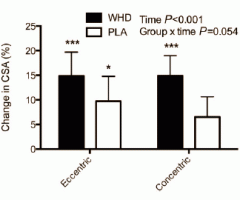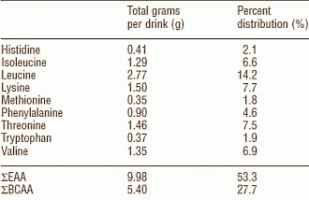Using whey during strength training helps tendons grow faster
If you?re interested in strengthening your knee ligaments ? or patellar tendons as your physiotherapist would call them ? then you?ll probably be interested in the article that Danish sports scientists published recently in the Scandinavian Journal of Medicine and Science in Sports. According to the article, you can make your ligaments and tendons stronger by using whey during your workouts.
If you?re interested in strengthening your knee ligaments ? or patellar tendons as your physiotherapist would call them ? then you?ll probably be interested in the article that Danish sports scientists published recently in the Scandinavian Journal of Medicine and Science in Sports. According to the article, you can make your ligaments and tendons stronger by using whey during your workouts.
The Danes, working at Aarhus University, did experiments with 22 active men whose average age was 24. The men trained their leg muscles on a leg extension machine three times a week for a period of 12 weeks. They did concentric movements to train one leg and eccentric movements to train the other.
Eleven of the men drank a shake containing 19.5 g whey hydrolysate and 19.5 g carbohydrates [WHD] during their workout; the other eleven drank a shake containing 39 g carbohydrates [PLA].
Before and after the training period the researchers did scans to measure the circumference of the trained leg muscles and the patellar tendon. This ligament attaches your knee bone to your shinbone.
As you might expect, the whey supplementation boosted the growth of the leg muscles. But the whey also increased the size of the knee ligament, as you can see in the first figure below. The type of training ? eccentric or concentric ? was not a relevant factor.
The composition of the whey preparation the scientists used is shown above. Whey contains large amounts of leucine, and these are also present in the whey product used. The researchers suspect that the leucine is the reason why the whey helped the collagen in the knee ligaments to grow. Animal studies have shown that leucine has an anabolic effect on collagen.
?This could have important clinical implications since augmented tendon hypertrophy may lower the mechanical stress (thereby also strain) on the tendon during exercise and potentially assist in tendon rehabilitation following injury?, the researchers write.
The study was paid for by Arla Foods Ingredients Group, which was also the manufacturer of the whey hydrolysate that was used.
Whey protein hydrolysate augments tendon and muscle hypertrophy independent of resistance exercise contraction mode.
Farup J, Rahbek SK, Vendelbo MH, Matzon A, Hindhede J, Bejder A, Ringgard S, Vissing K.
Source
Section of Sport Science, Department of Public Health, Aarhus University, Aarhus, Denmark.
Abstract
In a comparative study, we investigated the effects of maximal eccentric or concentric resistance training combined with whey protein or placebo on muscle and tendon hypertrophy. 22 subjects were allocated into either a high-leucine whey protein hydrolysate?+?carbohydrate group (WHD) or a carbohydrate group (PLA). Subjects completed 12?weeks maximal knee extensor training with one leg using eccentric contractions and the other using concentric contractions. Before and after training cross-sectional area (CSA) of m. quadriceps and patellar tendon CSA was quantified with magnetic resonance imaging and a isometric strength test was used to assess maximal voluntary contraction (MVC) and rate of force development (RFD). Quadriceps CSA increased by 7.3???1.0% (P?< ?0.001) in WHD and 3.4???0.8% (P?).
If you?re interested in strengthening your knee ligaments ? or patellar tendons as your physiotherapist would call them ? then you?ll probably be interested in the article that Danish sports scientists published recently in the Scandinavian Journal of Medicine and Science in Sports. According to the article, you can make your ligaments and tendons stronger by using whey during your workouts.
If you?re interested in strengthening your knee ligaments ? or patellar tendons as your physiotherapist would call them ? then you?ll probably be interested in the article that Danish sports scientists published recently in the Scandinavian Journal of Medicine and Science in Sports. According to the article, you can make your ligaments and tendons stronger by using whey during your workouts.
The Danes, working at Aarhus University, did experiments with 22 active men whose average age was 24. The men trained their leg muscles on a leg extension machine three times a week for a period of 12 weeks. They did concentric movements to train one leg and eccentric movements to train the other.
Eleven of the men drank a shake containing 19.5 g whey hydrolysate and 19.5 g carbohydrates [WHD] during their workout; the other eleven drank a shake containing 39 g carbohydrates [PLA].
Before and after the training period the researchers did scans to measure the circumference of the trained leg muscles and the patellar tendon. This ligament attaches your knee bone to your shinbone.
As you might expect, the whey supplementation boosted the growth of the leg muscles. But the whey also increased the size of the knee ligament, as you can see in the first figure below. The type of training ? eccentric or concentric ? was not a relevant factor.
The composition of the whey preparation the scientists used is shown above. Whey contains large amounts of leucine, and these are also present in the whey product used. The researchers suspect that the leucine is the reason why the whey helped the collagen in the knee ligaments to grow. Animal studies have shown that leucine has an anabolic effect on collagen.
?This could have important clinical implications since augmented tendon hypertrophy may lower the mechanical stress (thereby also strain) on the tendon during exercise and potentially assist in tendon rehabilitation following injury?, the researchers write.
The study was paid for by Arla Foods Ingredients Group, which was also the manufacturer of the whey hydrolysate that was used.
Whey protein hydrolysate augments tendon and muscle hypertrophy independent of resistance exercise contraction mode.
Farup J, Rahbek SK, Vendelbo MH, Matzon A, Hindhede J, Bejder A, Ringgard S, Vissing K.
Source
Section of Sport Science, Department of Public Health, Aarhus University, Aarhus, Denmark.
Abstract
In a comparative study, we investigated the effects of maximal eccentric or concentric resistance training combined with whey protein or placebo on muscle and tendon hypertrophy. 22 subjects were allocated into either a high-leucine whey protein hydrolysate?+?carbohydrate group (WHD) or a carbohydrate group (PLA). Subjects completed 12?weeks maximal knee extensor training with one leg using eccentric contractions and the other using concentric contractions. Before and after training cross-sectional area (CSA) of m. quadriceps and patellar tendon CSA was quantified with magnetic resonance imaging and a isometric strength test was used to assess maximal voluntary contraction (MVC) and rate of force development (RFD). Quadriceps CSA increased by 7.3???1.0% (P?< ?0.001) in WHD and 3.4???0.8% (P?).




